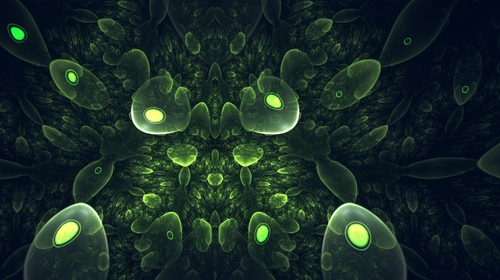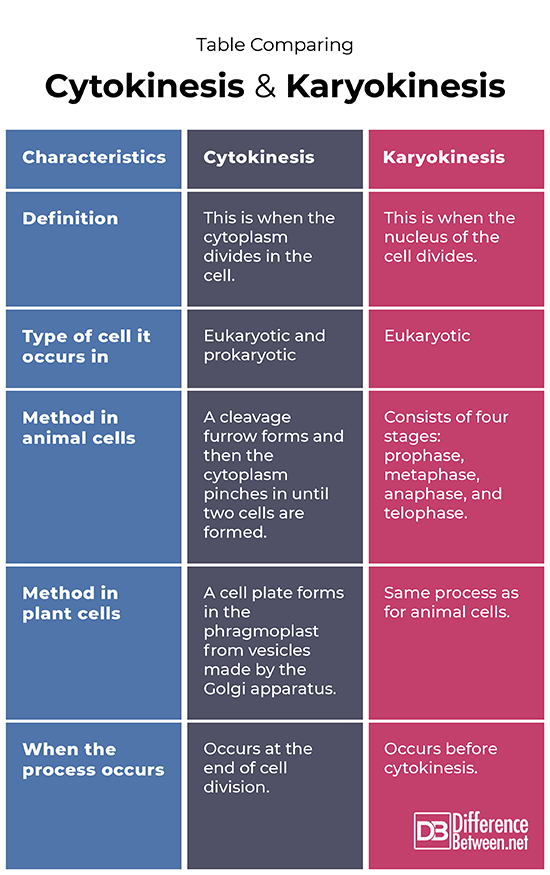Difference Between Cytokinesis and Karyokinesis
Cytokinesis is the separation of the cytoplasm of a cell. Karyokinesis is when the nucleus divides in a cell.

What is Cytokinesis?
Definition:
Cytokinesis can be defined as the dividing of the cytoplasm of a cell at the end of cell division.
Process in eukaryotes:
The process of cytokinesis varies depending on what type of cell is involved. In eukaryotic cells, the method of cytokinesis relies on a ring structure formed by the proteins of actin, actomyosin, and myosin II. This ring structure contracts and works along with spindle fibers found in the cytoplasm in order to achieve cytokinesis.
Process in plants and animals:
The process in plant cells starts with the budding of two types of vesicles from the Golgi apparatus. Membrane vesicles are transported by way of the cytoskeleton fibers to the center of the plant cell in an area known as the phragmoplast. These vesicles then fuse together to form a cell plate. Plants have a different process from animals because of the cell wall. In animal cells, a cleavage furrow forms in the middle of the cell. A contractile ring consisting of myosin II and F-actin fibers then forms at the base of this furrow. Molecular activity then occurs in which these protein fibers allow the cytoplasm to completely divide.

What is Karyokinesis?
Definition:
Karyokinesis can be defined as the division of the nucleus of a cell.
Process in eukaryotes:
Karyokinesis is the method by which the nucleus divides. Prior to karyokinesis, the DNA is replicated during interphase. This is important to ensure there is enough genetic material to distribute into two cells. There are four main stages that have to occur in karyokinesis; the stages in sequence from start to finish are prophase, metaphase, anaphase, and telophase.
Process in plants and animals:
Both animal and plant cells have the same basic karyokinesis. During prophase, the chromosomes condense, the nuclear envelope, and the nucleolus disintegrate. In metaphase, the chromosomes attach to spindle fibers. These chromosomes then line up in the equator of the cell. In the third stage, anaphase, chromosomes are pulled apart to opposite sides of the cell due to a shortening of the spindle fibers. Telophase is the final stage of karyokinesis in which the nuclear envelope and nucleolus reform around the chromosomes to form two new nuclei at the polar ends of the cell.
Difference between Cytokinesis and Karyokinesis?
Definition
Cytokinesis is defined as the process in which the cytoplasm is dividing. Karyokinesis is defined as the process in which the nucleus of the cell undergoes division.
Type of cell it occurs in
Cytokinesis occurs in both prokaryotic and eukaryotic cells. Karyokinesis only occurs in eukaryotic cells.
Method in animal cells
The method of cytokinesis in animal cells is that a cleavage furrow forms and then the cytoplasm pinches in until two cells are formed. The method of karyokinesis in animal cells includes four stages: prophase, metaphase, anaphase, and telophase.
Method in plant cells
The method of cytokinesis that happens in plant cells is that a cell plate forms in the phragmoplast. Karyokinesis in plant cells occurs in the same way as in animal cells.
When the process occurs
Cytokinesis occurs at the end of cell division. Karyokinesis occurs before cytokinesis at the start of cell division.
Table comparing Cytokinesis and Karyokinesis

Summary of Cytokinesis Vs. Karyokinesis
- Cytokinesis and karyokinesis are both methods that take place during cell division.
- Karyokinesis only occurs in eukaryotes because prokaryotes don’t have a nucleus.
- Cytokinesis occurs in different ways in animal cells and plant cells.
FAQ
What are the specific differences between animal and plant karyokinesis and cytokinesis?
Karyokinesis is similar in plants and animals with the nucleus dividing during mitosis. The process of cytokinesis in plants involves a cell plate being formed while in animal cells a cleavage furrow is formed.
What is the difference between cytokinesis and mitosis?
Cytokinesis only refers to the cytoplasm of a cell dividing while mitosis is the division of the organelles and the nucleus, formation of spindle, and movement of chromosomes apart.
Does karyokinesis follow cytokinesis?
No, karyokinesis is when the nucleus divides which has to occur before the cytoplasm divides or else there will be a daughter cell that has no nucleus and genetic material in it.
Does karyokinesis occur before cytokinesis?
Yes, karyokinesis has to happen prior to cytokinesis happening to ensure genetic information is distributed correctly and in the same quantity in each of the daughter cells that are produced at the end of the cytoplasmic division.
What is the difference between mitosis and karyokinesis?
Mitosis includes more than the nucleus dividing it also includes organelles being separated. Karyokinesis only relates to activities during the nucleus division.
How do you explain cytokinesis?
Cytokinesis is the last stage of cell division in which a parent cell divides into two daughter cells by virtue of the separation of the cytoplasm. The word cytokinesis means splitting of the cytoplasm.
What do you mean by karyokinesis?
The word karyokinesis means splitting of the nucleus and is when the nucleus of a cell divides during cell division.
What is the meaning of karyokinesis not followed by cytokinesis?
This does occur in some organisms resulting in the formation of a syncytium. The syncytium is a cell with multiple nuclei present.
- Difference Between Rumination and Regurgitation - June 13, 2024
- Difference Between Pyelectasis and Hydronephrosis - June 4, 2024
- Difference Between Cellulitis and Erysipelas - June 1, 2024
Search DifferenceBetween.net :
Leave a Response
References :
[0]Jürgens, Gerd. "Cytokinesis in higher plants." Annu. Rev. Plant Biol. 56 (2005): 281-299.
[1]Marchetti, Maria A., et al. "Import of proteins into the trypanosome nucleus and their distribution at karyokinesis." Journal of cell science 113.5 (2000): 899-906.
[2]Nanninga, Nanne. "Cytokinesis in prokaryotes and eukaryotes: common principles and different solutions." Microbiology and molecular biology reviews 65.2 (2001): 319-333.
